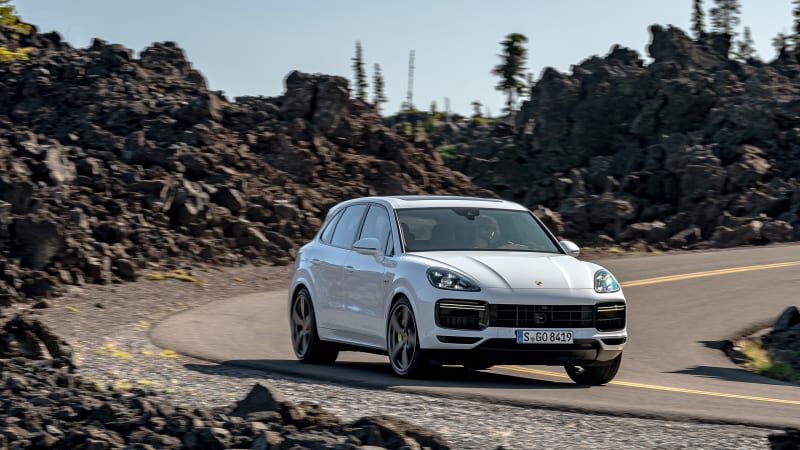2020 Porsche Cayenne Turbo S E-Hybrid First Drive | Boosted and juiced
https://ift.tt/2KHgV7V
EUGENE, Ore. — For the first time, the ultimate version of the Porsche Cayenne is a hybrid, as the brand moves to make electrification more central to its powertrain strategy. The Turbo S E-Hybrid is the new range topper of the Cayenne lineup, in place of the non-electrified Turbo S that was the ultimate iteration of the previous-gen Cayenne. With the new Cayenne, the Turbo S comes only in E-Hybrid form and a regular Cayenne Turbo sits one rung down, a hierarchy that mirrors the offerings in the Panamera family. Like all other Cayenne models, the Turbo S E-Hybrid is offered both in a traditional SUV body — now shapelier as a result of the third-gen redesign — as well as a fastback Coupe. We drove the former at a launch event in southwestern Oregon.
The 2020 Porsche Cayennne Turbo S E-Hybrid marries the twin-turbocharged 4.0-liter V8 of the regular Turbo with the electric motor and battery pack from the Cayenne E-Hybrid. The result is an increase from the Turbo’s 541 horsepower and 567 pound-feet of torque to 670 ponies and 663 lb-ft. As in every Cayenne, all-wheel drive and an eight-speed automatic are standard.
That output obviously dwarfs the regular Turbo’s, but the extra muscle must overcome the Turbo S E-Hybrid’s considerable extra weight: some 600 pounds’ worth. It does, but just barely. According the Porsche, the Turbo blasts from zero to 60 mph in 3.7 seconds (with Launch Control) and can reach 177 mph. For the electrified Turbo S E-Hybrid, those figures are 3.6 seconds and 183 mph, making the new Turbo S E-Hybrid the quickest and the fastest Cayenne ever.
The electric side of the Turbo S powertrain is identical to that of the Cayenne E-Hybrid. There’s a 135-hp electric motor located between the engine and the eight-speed automatic gearbox. A 14.1-kWh lithium-ion battery pack supplies the electrons and is located under the rear cargo floor. As befits the Turbo S’s need for speed, the faster, 7.2-kWh charger that’s optional on the regular E-Hybrid is standard here. It can replenish a depleted battery in as little as 2.5 hours (Porsche has provided no estimates for fuel economy or range).

The vehicle starts out in EV mode – called E-Power here – using battery power only. Once the battery is depleted or if the driver calls for more than moderate acceleration, the system switches to hybrid operation – Hybrid Auto mode – which uses the gas engine, the electric motor, or a combination of the two. Select Sport or Sport Plus, and the engine is prevented from shutting down. It also will recharge the battery to a minimum of 30 percent charge so that electric boost is always available. The Sport Chrono package is standard here, which means manually switching among the four main drive modes is done via a dial on the steering wheel, and pushing the Sport Response button at the center triggers a 20-second max-boost mode.
Although the hybrid system logic mirrors that of the V6 E-Hybrid, the Turbo S is set apart by its blistering twin-turbo V8 that speaks with a throaty rumble and pops on the overrun with our test vehicle’s optional Sport Exhaust. Overall, this powertrain is way more Turbo than Hybrid; aside from the initial EV driving, the hybrid operation is all but invisible. In Hybrid Auto mode, the engine will shut down briefly when coasting – even at highway speeds – but you wouldn’t know it except that the tach needle drops to zero. Roll back into the throttle and the engine instantly restarts, an operation that is utterly seamless. In the two Sport modes, the engine is always engaged and the electric motor just adds more oomph.
And there is so much oomph. Acceleration from rest is smooth, linear, and strong. Speed builds incredibly quickly and it’s a real monster in passing maneuvers, slingshotting past traffic dawdlers. And yet this ultimate Cayenne is also docile and tractable when puttering around town, its throttle response smooth and linear despite the duality of its powertrain.
Most of the chassis wizardry that costs extra on lesser Cayennes is included on the Turbo S E-Hybrid. That includes Porsche’s active anti-roll bars (Porsche Dynamic Chassis Control), which requires still more electrification with its own 48-volt electrical system. Adaptive air springs are standard here, as they are on the Turbo, and can alter the ride height by 3.6 inches. The suspension can be set in three different levels of firmness, but no matter which is selected, the combination of active anti-roll bars, air springs, and the standard adaptive dampers quell any thoughts of body roll.




One item that remains optional even at this level is Porsche’s four-wheel steering system, which steers the rear wheels opposite the fronts – up to 3 degrees – at speeds of 49 mph or less, shaving roughly 2 feet off the turning circle. At higher speeds, the rear wheels steer in phase with the fronts for more stable handling. The vehicle we drove had the system, and we found turn-in to be eager. The steering is deliciously accurate and well weighted – a credit to the badge on the hood.
Porsche carbon ceramic brake rotors also are standard here (they’re optional elsewhere in the lineup). They’re a bit difficult to modulate but then again, so are the Cayenne E-Hybrid’s regenerative brakes with cast iron rotors. Therefore, maybe it’s the regenerative bit that’s the issue as we recently had no such issue with a regular Cayenne Turbo with the carbon ceramics.
Unlike some of Porsche’s high-zoot sports cars, this max-horsepower Cayenne is dressed fairly conservatively. Perhaps its most notable exterior feature is the active rear roof spoiler (it’s on the Turbo as well) that flips up at speeds above 99 mph to increase downforce on the rear axle. Its angle also increases in Sport Plus mode for greater downforce, or to minimize wind buffeting if the panoramic sunroof is open. Under high-speed braking, it deploys to its steepest angle to act as an air brake.
Other points of visual differentiation include a large front air intake, 21-inch AeroDesign wheels, and the now-familiar acid-green accents common to Porsche’s electrified offerings. (For those who’d rather not make such an easily identified green statement, those accents can be deleted and the brake calipers painted in yellow instead.)




Inside, our Turbo S E-Hybrid was decked out in the manner of a top-trim model, with rich-looking two-tone leather covering most surfaces and suede material on the headliner. Superb 18-way adaptive sport seats are standard, but 14-way massaging “comfort” seats are available for those more inclined to in-car pampering than lateral support. The back seat still slides and reclines, but behind it, cargo volume is down by about 4.5 cubic-feet in both traditional and coupe body styles.
All Cayennes feature grab handles incorporated into the center console and the door armrests, and a ramp-like center stack with flat-panel buttons that incorporate haptic feedback. The Cayenne thankfully doesn’t take things as far as does the Panamera, however, preserving physical switches for temperature and fan speed, and avoiding the silliness of touchscreen-controlled air vents. The center touchscreen is a highly configurable 12.3-inch unit with crisp resolution and speedy responses. A rotary knob provides redundant functionality. The instrument cluster consists of configurable screens flanking the central tachometer, and the Turbo S also comes standard with a head-up display.
Pricing for the Turbo S E-Hybrid opens at $163,150, which is $36,500 more than the Cayenne Turbo. The Coupe version is $165,650. The E-Hybrid Turbo S, however, does come with additional standard equipment including the carbon-ceramic brake rotors, active anti-roll bars, and the Sport Chrono package. As Porsche works to change the thinking about hybrids from green tech to speed tech, the Cayenne Turbo S E-Hybrid is a compelling example. You won’t buy this fire-breathing SUV for its veneer of green cred, you’ll buy it for its performance.
Auto Blog
via Autoblog https://ift.tt/1afPJWx
August 12, 2019 at 06:41PM
